Architecture Parlante, French for “speaking architecture”, is an architecture aesthetic meant to convey its purpose through its form. It originates in the 18th century during the Revolutionary period to describe the works of the French architects Claude-Nicolas Ledoux, Étienne-Louis Boullée, and Jean-Jacques Lequeu. Although not used as a term in modern architecture, a modern equivalency would be Postmodern architecture, which carries similar ideas of providing context for a building’s purpose through its form. I am introducing Architecture Parlante specifically to discuss the French artists who brought it into existence and its legacy.
The first, and most infamous, example of “speaking architecture” is by the architect Claude-Nicolas Ledoux. Ledoux was one of the first to promote Neoclassical architecture in France. His most ambitious design was the “Royal Saltworks at Arc-et-Senans”, a design for a centralized salt mine funded by the French Royalty. Ledoux saw it as an “ideal city” and utopian in nature. However, the masses saw his work as part of the “Old Regime” and a majority of his creations and progress were destroyed in the French Revolution.
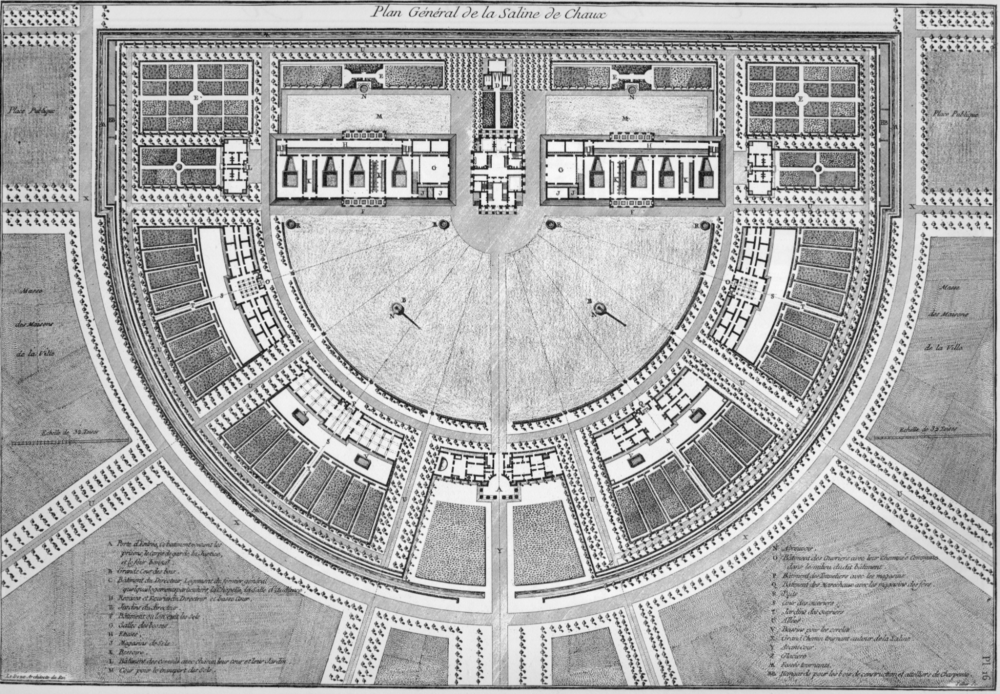
Claude-Nicolas Ledoux. (1775). Royal Saltworks at Arc-et-Senans, Second Plan.
Much of Ledoux’s work falls under the aesthetic of Architecture Parlante, but one of the clearest is his design for a “house of pleasure” in Paris. Although never built, the plans for this proposed design clearly show the idea of architecture that speaks of its purpose through its form. Inconspicuous at first, if you view the floor plans for this design you may have a better understanding of Ledoux’s architectural choices.
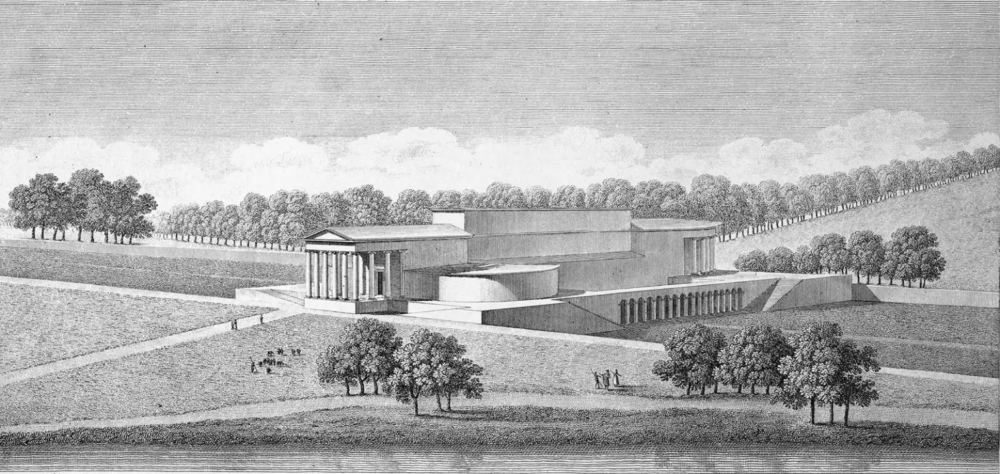
Claude-Nicolas Ledoux. (1780). Oikema, House of Pleasure.
Another French architect around this time promoting neoclassical architecture was Étienne-Louis Boullée. Although much of his grander visions were seen as impossible to build, they developed a distinct geometric style of architecture that he passed on to his student at the École Nationale des Ponts et Chaussées . One of his most notable designs was a proposal for a Cenotaph (monument) for the late scientist Isaac Newton. The proposed building would be a large spherical building. Standing taller than the great pyramid of Giza, it would be 150m tall. This prominent building, although not explicitly expressing its purpose, would be memorable and distinct enough to convey its importance and the magnitude of what it was representing.
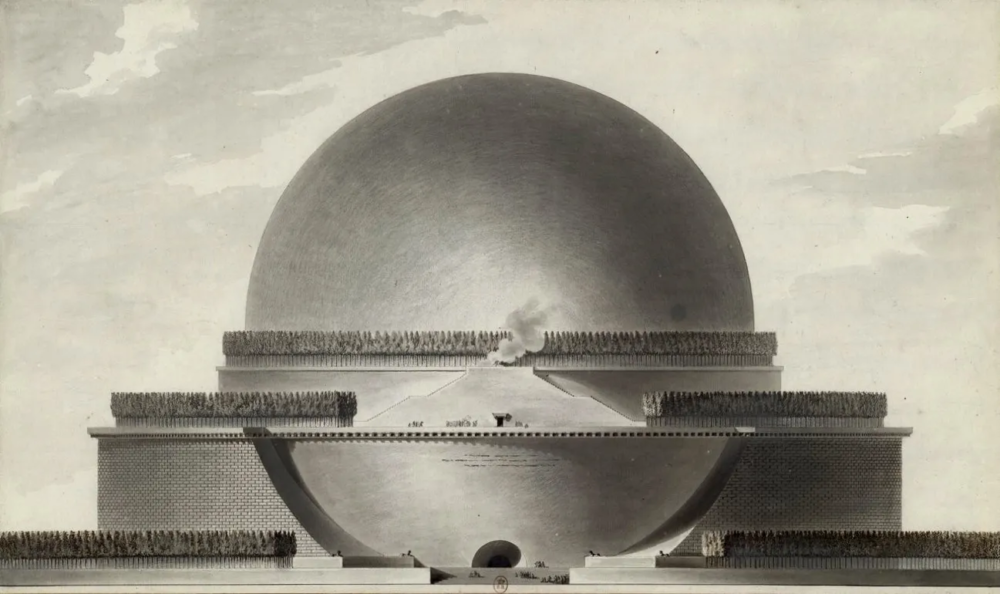
Étienne-Louis Boullée. (1784). Cénotaphe à Newton.
Boullée made many similar grandiose proposals for libraries, operas, and pictured below, a cathedral. The scale and lack of ornamentation is what sets his designs apart from many at the time, with the idea of grandeur being the message communicated by the design. These designs also drew criticism for being egotistical due to their impractical grandeur.

Étienne-Louis Boullée. (1782). Design for a Metropolitan Cathedral.
The other French artist attributed to Architecture Parlante is Jean-Jacques Lequeu. He also proposed architectural designs of grandeur, influenced by the pressure at the time to great works of greatness with no practicality or budget in mind. An example of this philosophy is shown in his design for a “temple of the Earth”, where the building takes the shape of the Earth. The design is wholly impractical but very clearly demonstrates a philosophy of communicating the purpose of the design through its form.
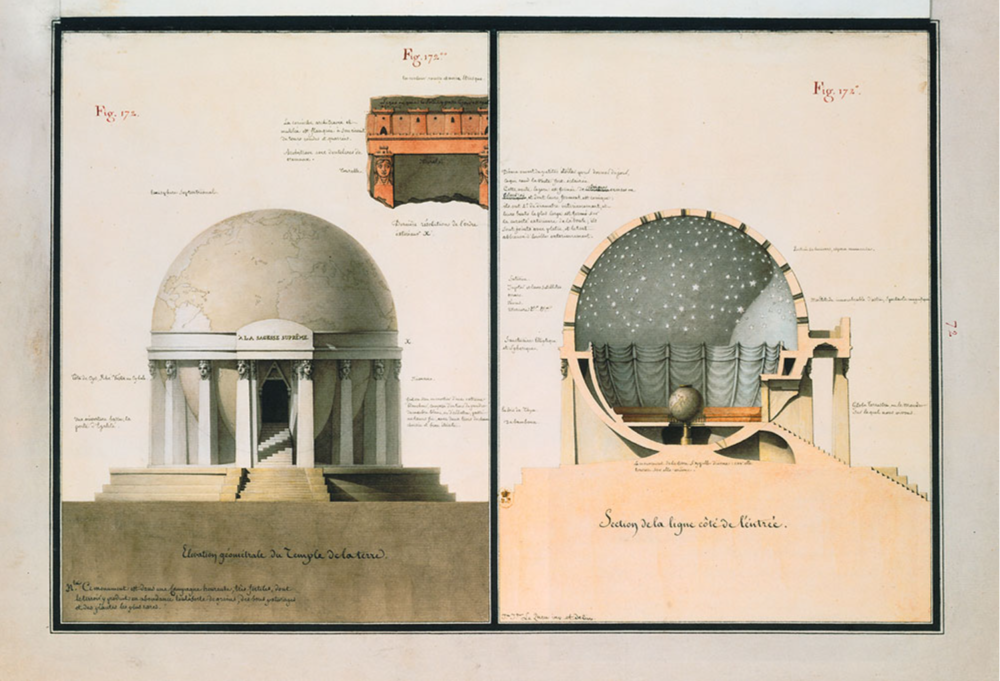
Jean-Jacques Lequeu. (1794). Design for a Temple of the Earth.
Architecture Parlante drew much criticism in its time. In “Architecture In The Age Of Reason Baroque and Post-Baroque in England, Italy, and France”, Emil Kaufamn writes that this term was first used as a criticism of the mentioned architects. Their designs all share visions of grandeur, centralization, and without regard for a budget, which aligned with the ideals of the French Royalty but soon fell unpopular after the French Revolution. Although never built, these designs were influential in both the beginning of French Neoclassical architecture and the philosophy of showing the function of a building through its form.
Today, the legacy of Architecture Parlante can still be seen in the country of its origin. The Bibliothèque nationale de France (National Library of France), which holds many of the original documents of the designs shown above, is itself shaped like four massive, opened books. This was a design by Dominique Perrault and stands as a modern day equivalent to the grandiose designs of the three French architects who never saw their designs come to life.
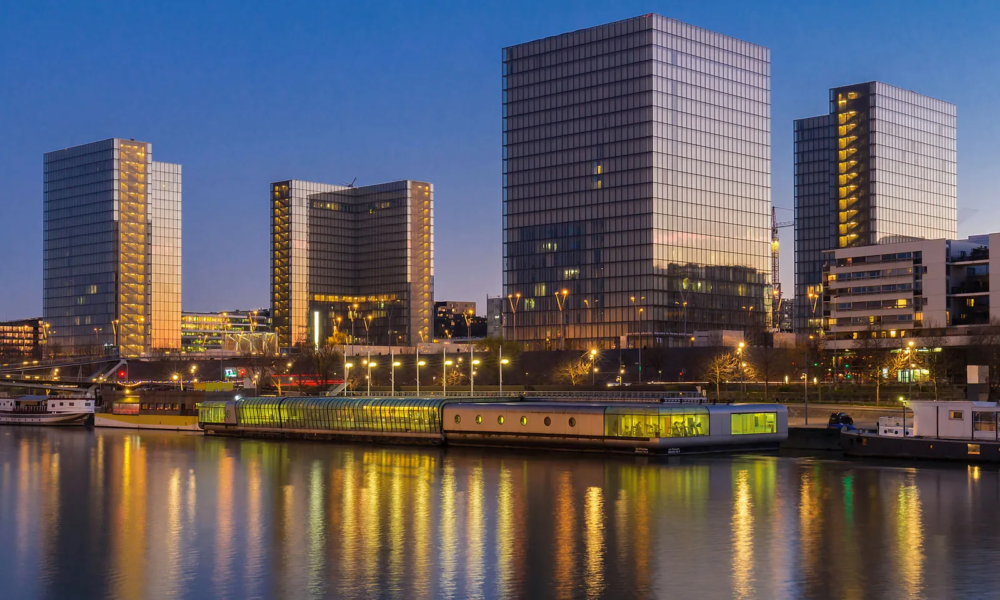
Dominique Perrault. (1995). Bibliothèque nationale de France.
Resources:
Blumberg, N. (2015, December). Dominique Perrault: French architect and designer. Britannica. https://www.britannica.com/biography/Dominique-Perrault
Lequeu, Jean-Jacques. Design for a Temple of the Earth, from Civil Architecture. 1794. Bibliothèque nationale de France, Departement des Estampes et de la photographie. https://www.themorgan.org/exhibitions/online/lequeu/design-temple-earth-civil-architecture
Boullee, Etienne-Louis. Project for a metropolitan cathedral in the form of a Greek cross with a domed centre. 1782. RIBA Collections. https://www.ribapix.com/Project-for-a-metropolitan-cathedral-in-the-form-of-a-Greek-cross-with-a-domed-centre_RIBA3079-37
Popova, Maria. A Cenotaph for Newton: The Poetry of Public Spaces, the Architecture of Shadow, and How Trees Inspired the World’s First Planetarium Design. The Marginalian. https://www.themarginalian.org/2021/03/18/etienne-louis-boullee-newton-cenotaph/
Ledoux, Claude-Nicolas. “Oikema House of Pleasure“. ArchEyes. 20 March, 2020. https://archeyes.com/oikema-house-pleasure-claude-nicolas-ledoux/
Emil Kaufmann. Three Revolutionary Architects: Boullée, Ledoux, and Lequeu. American Philosophical Society, 1952.
Emil Kaufmann. Architecture In The Age Of Reason Baroque and Post-Baroque in England, Italy, and France. Harvard University Press, 1955.


5 Comments. Leave new
Membrane Architecture
Neesaun Zarbakhat Architecture is a renowned architectural firm based in Islamabad, Pakistan, known for its innovative and sustainable designs. With a commitment to excellence and a passion for creating functional and aesthetically pleasing spaces, Neesaun Zarbakhat has become a leading force in shaping the city’s skyline.
Very interesting aesthetic, I haven’t heard of it before. All of the plans and structures seem grandiose in design. Besides France is there any additional buildings or plans that have originated outside of its country of origin?
Thank you for the comment. Architecture Parlante is referred to as a “Nonce order” which basically means it is an order of architecture that is outdated and isn’t used anymore. A modern term for this style of architecture would be French Neoclassicalism. Neoclassicalism can be seen in buildings outside of France such as the U.S. Capitol Building. The library I referenced at the end is not neoclassical, but is an example of contemporary architecture. I referenced the library specifically it because it kept the Parisian tradition of grand, monumental architecture begun by Architecture Parlante. So as much as it is an aesthetic, it is also a piece of French culture. I hope this helps answer your question.
I hadn’t heard of this architectural style before, but the design philosophy is quite interesting! How much is this aesthetic dictated by the grandeur of the designs compared with conveying the design intent through the construction? I really enjoyed seeing the grandeur of the different architectural designs, even if their practicality was limited. The “house of pleasure” was quite a good, and humorous, example of how the architects used form to show the intended use of a structure. Though with the “house of pleasure” the context may be more or less difficult to discern from the exterior! I was also wondering if the roots of this aesthetic, conveying use with design, have had any major influences outside of architecture or are there any design movements that co-opted this idea? It was quite interesting to learn that the term Architecture Parlante was initially used as a criticism of this architectural style. I can definitely understand how this style would be shunned following the French revolution, but I am glad to see that it has endured in some sense because it is an interesting design philosophy!
Thank you for the comment. What makes this aesthetic differ from just neoclassical is the grandeur and impracticality of the designs. Conveying the intent through the design was a part of this impracticality. What you describe as impracticality through the house of pleasure, where the common person would not even notice its design, is part of the critique of this architecture style and why it was unfavorable to the masses at the time. This movement lived and died with the French revolution, but French neoclassical architecture lived on. The three architects mentioned where the major proponents for neoclassical architecture at the time. Grand, monumental designs built in modern-day France are also still tied to Parisian architecture born in this time period. I hope this helps answer your questions.